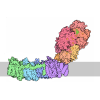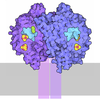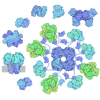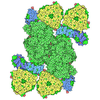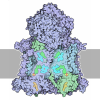+ Open data
Open data
- Basic information
Basic information
| Entry | Database: PDB / ID: 9n5u | ||||||
|---|---|---|---|---|---|---|---|
| Title | Structure of the Thermococcus sibiricus NfnABC complex | ||||||
 Components Components |
| ||||||
 Keywords Keywords | ELECTRON TRANSPORT / Flavin-based electron bifurcation / Bfu family / Nfn-ABC / cryo-EM structures / flavo-FeS cluster | ||||||
| Function / homology |  Function and homology information Function and homology informationNADH dehydrogenase (ubiquinone) activity / ATP synthesis coupled electron transport / 2 iron, 2 sulfur cluster binding / 4 iron, 4 sulfur cluster binding / oxidoreductase activity / metal ion binding / membrane Similarity search - Function | ||||||
| Biological species |   Thermococcus sibiricus (archaea) Thermococcus sibiricus (archaea) | ||||||
| Method | ELECTRON MICROSCOPY / single particle reconstruction / cryo EM / Resolution: 2.85 Å | ||||||
 Authors Authors | Xiao, X. / Li, H. | ||||||
| Funding support |  United States, 1items United States, 1items
| ||||||
 Citation Citation |  Journal: J Biol Chem / Year: 2025 Journal: J Biol Chem / Year: 2025Title: Cryo-EM structures define the electron bifurcating flavobicluster and ferredoxin binding site in an archaeal Nfn-Bfu transhydrogenase. Authors: Xiansha Xiao / Gerrit J Schut / Xiang Feng / Diep M N Nguyen / Haiyan Huang / Shuning Wang / Huilin Li / Michael W W Adams /  Abstract: Flavin-based electron bifurcation couples exergonic and endergonic redox reactions in one enzyme complex to circumvent thermodynamic barriers and minimize free energy loss. Two unrelated enzymes ...Flavin-based electron bifurcation couples exergonic and endergonic redox reactions in one enzyme complex to circumvent thermodynamic barriers and minimize free energy loss. Two unrelated enzymes designated NfnSL and NfnABC catalyze the NADPH-dependent reduction of ferredoxin and NAD. Bifurcation by NfnSL resides with a single FAD but the bifurcation mechanism of NfnABC, which represents the diverse and ubiquitous Bfu enzyme family, is completely different and largely unknown. Using cryo-EM structures of an archaeal NfnABC, we show that its bifurcation site is a flavobicluster consisting of FMN, one [4Fe-4S] and one [2Fe-2S] cluster where zinc atoms replace two additional clusters previously identified in other Bfu enzymes. NADH binds to the flavobicluster site of NfnABC and induces conformational changes that allow ferredoxin to bind between the C-terminal domains of NfnC and NfnB. Site-directed mutational analyses support the proposed mechanism that is likely conserved in all members of the Bfu enzyme family. | ||||||
| History |
|
- Structure visualization
Structure visualization
| Structure viewer | Molecule:  Molmil Molmil Jmol/JSmol Jmol/JSmol |
|---|
- Downloads & links
Downloads & links
- Download
Download
| PDBx/mmCIF format |  9n5u.cif.gz 9n5u.cif.gz | 344.9 KB | Display |  PDBx/mmCIF format PDBx/mmCIF format |
|---|---|---|---|---|
| PDB format |  pdb9n5u.ent.gz pdb9n5u.ent.gz | 272.3 KB | Display |  PDB format PDB format |
| PDBx/mmJSON format |  9n5u.json.gz 9n5u.json.gz | Tree view |  PDBx/mmJSON format PDBx/mmJSON format | |
| Others |  Other downloads Other downloads |
-Validation report
| Summary document |  9n5u_validation.pdf.gz 9n5u_validation.pdf.gz | 1.4 MB | Display |  wwPDB validaton report wwPDB validaton report |
|---|---|---|---|---|
| Full document |  9n5u_full_validation.pdf.gz 9n5u_full_validation.pdf.gz | 1.4 MB | Display | |
| Data in XML |  9n5u_validation.xml.gz 9n5u_validation.xml.gz | 59.5 KB | Display | |
| Data in CIF |  9n5u_validation.cif.gz 9n5u_validation.cif.gz | 89.8 KB | Display | |
| Arichive directory |  https://data.pdbj.org/pub/pdb/validation_reports/n5/9n5u https://data.pdbj.org/pub/pdb/validation_reports/n5/9n5u ftp://data.pdbj.org/pub/pdb/validation_reports/n5/9n5u ftp://data.pdbj.org/pub/pdb/validation_reports/n5/9n5u | HTTPS FTP |
-Related structure data
| Related structure data |  49039MC  9n5vC M: map data used to model this data C: citing same article ( |
|---|---|
| Similar structure data | Similarity search - Function & homology  F&H Search F&H Search |
- Links
Links
- Assembly
Assembly
| Deposited unit | 
|
|---|---|
| 1 |
|
- Components
Components
-Protein , 3 types, 3 molecules ABC
| #1: Protein | Mass: 107912.820 Da / Num. of mol.: 1 Source method: isolated from a genetically manipulated source Source: (gene. exp.)   Thermococcus sibiricus (archaea) / Gene: TSIB_1517 / Production host: Thermococcus sibiricus (archaea) / Gene: TSIB_1517 / Production host:   Pyrococcus furiosus (archaea) / References: UniProt: C6A4M3 Pyrococcus furiosus (archaea) / References: UniProt: C6A4M3 |
|---|---|
| #2: Protein | Mass: 66237.703 Da / Num. of mol.: 1 Source method: isolated from a genetically manipulated source Source: (gene. exp.)   Thermococcus sibiricus (archaea) / Gene: XD54_1074 / Production host: Thermococcus sibiricus (archaea) / Gene: XD54_1074 / Production host:   Pyrococcus furiosus (archaea) / References: UniProt: A0A117L1A0 Pyrococcus furiosus (archaea) / References: UniProt: A0A117L1A0 |
| #3: Protein | Mass: 17382.266 Da / Num. of mol.: 1 Source method: isolated from a genetically manipulated source Source: (gene. exp.)   Thermococcus sibiricus (archaea) / Gene: XD54_1073 / Production host: Thermococcus sibiricus (archaea) / Gene: XD54_1073 / Production host:   Pyrococcus furiosus (archaea) / References: UniProt: A0A117L1U2 Pyrococcus furiosus (archaea) / References: UniProt: A0A117L1U2 |
-Non-polymers , 5 types, 14 molecules 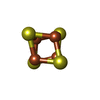
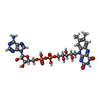
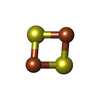
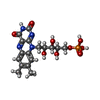





| #4: Chemical | ChemComp-SF4 / #5: Chemical | ChemComp-FAD / | #6: Chemical | #7: Chemical | ChemComp-FMN / | #8: Chemical | |
|---|
-Details
| Has ligand of interest | Y |
|---|---|
| Has protein modification | N |
-Experimental details
-Experiment
| Experiment | Method: ELECTRON MICROSCOPY |
|---|---|
| EM experiment | Aggregation state: PARTICLE / 3D reconstruction method: single particle reconstruction |
- Sample preparation
Sample preparation
| Component | Name: Ternary complex of the Tsi NfnABC complex / Type: COMPLEX / Entity ID: #1-#3 / Source: RECOMBINANT |
|---|---|
| Source (natural) | Organism:   Thermococcus sibiricus (archaea) Thermococcus sibiricus (archaea) |
| Source (recombinant) | Organism:   Pyrococcus furiosus (archaea) Pyrococcus furiosus (archaea) |
| Buffer solution | pH: 7.5 |
| Specimen | Conc.: 0.2 mg/ml / Embedding applied: NO / Shadowing applied: NO / Staining applied: NO / Vitrification applied: YES |
| Specimen support | Grid material: GOLD / Grid mesh size: 300 divisions/in. / Grid type: Quantifoil R1.2/1.3 |
| Vitrification | Instrument: FEI VITROBOT MARK II / Cryogen name: ETHANE / Humidity: 100 % / Chamber temperature: 283.15 K |
- Electron microscopy imaging
Electron microscopy imaging
| Experimental equipment |  Model: Titan Krios / Image courtesy: FEI Company |
|---|---|
| Microscopy | Model: TFS KRIOS |
| Electron gun | Electron source:  FIELD EMISSION GUN / Accelerating voltage: 300 kV / Illumination mode: FLOOD BEAM FIELD EMISSION GUN / Accelerating voltage: 300 kV / Illumination mode: FLOOD BEAM |
| Electron lens | Mode: BRIGHT FIELD / Nominal magnification: 105000 X / Nominal defocus max: 1800 nm / Nominal defocus min: 1300 nm / Cs: 2.7 mm / C2 aperture diameter: 100 µm / Alignment procedure: COMA FREE |
| Specimen holder | Cryogen: NITROGEN / Specimen holder model: FEI TITAN KRIOS AUTOGRID HOLDER |
| Image recording | Average exposure time: 1.5 sec. / Electron dose: 60 e/Å2 / Detector mode: SUPER-RESOLUTION / Film or detector model: GATAN K3 BIOQUANTUM (6k x 4k) / Num. of real images: 18072 |
| EM imaging optics | Energyfilter name: GIF Bioquantum / Energyfilter slit width: 20 eV |
| Image scans | Movie frames/image: 30 |
- Processing
Processing
| EM software |
| ||||||||||||||||||||||||||||||||||||||||
|---|---|---|---|---|---|---|---|---|---|---|---|---|---|---|---|---|---|---|---|---|---|---|---|---|---|---|---|---|---|---|---|---|---|---|---|---|---|---|---|---|---|
| CTF correction | Type: PHASE FLIPPING AND AMPLITUDE CORRECTION | ||||||||||||||||||||||||||||||||||||||||
| Particle selection | Num. of particles selected: 14943071 | ||||||||||||||||||||||||||||||||||||||||
| 3D reconstruction | Resolution: 2.85 Å / Resolution method: FSC 0.143 CUT-OFF / Num. of particles: 198898 / Symmetry type: POINT | ||||||||||||||||||||||||||||||||||||||||
| Atomic model building | Protocol: AB INITIO MODEL | ||||||||||||||||||||||||||||||||||||||||
| Atomic model building | Source name: AlphaFold / Type: in silico model | ||||||||||||||||||||||||||||||||||||||||
| Refinement | Highest resolution: 2.85 Å Stereochemistry target values: REAL-SPACE (WEIGHTED MAP SUM AT ATOM CENTERS) | ||||||||||||||||||||||||||||||||||||||||
| Refine LS restraints |
|
 Movie
Movie Controller
Controller




 PDBj
PDBj